
In port areas, two techniques may be employed to
reduce evaporation and restrict the spreading of
vapours. The first involves reducing vapours using
water spray curtains, which dilute the toxic cloud,
reduce the concentration of gas and limit the size
of the danger area. This is effective on hydrophilic•
products. The second technique involves spreading a
layer of foam over the pollutant to reduce its evaporation
rate.
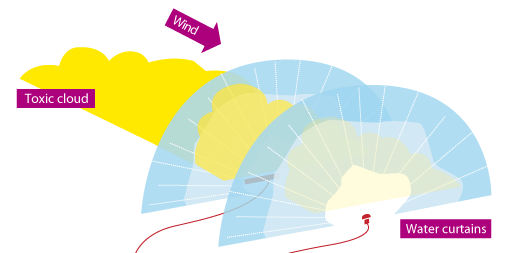
In 1976 in the port of Landskrona (Sweden), a
pipe burst when unloading a cargo of anhydrous
ammonia• from the gas carrier René 16. A vast
cloud enveloped the ship and drifted towards a
shipyard. The response team used water spray to
reduce and dissolve part of the gas cloud and
to protect the operator in charge of closing the
valve above the leak point.
Containment and filtration of dissolvers in water
When a soluble substance is spilt in a port or harbour, it is sometimes possible to contain the pollution by shutting off the doors of a drydock facility or the sluice gates•. The pollutant can then be treated using mobile truck-mounted units. These units are composed of high flow rate pumps which send the polluted water through large filter cartridges that retain the pollutant.
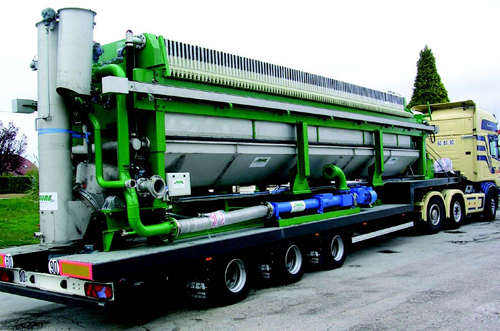
Some information on the use of activated carbon to filter
wastewater:
www.lenntech.com/library/adsorption/adsorption.htm
Recovery of sinkers
In coastal or port areas, sinking substances can be recovered on the bottom by dredging. This mud and sediment mechanical a excavation• technique is implemented by vessels or a barges• equipped with a a dredge• which may simply consist of buckets or be fitted with pumps. The waste collected is loaded onto the vessel to be treated in specialized centres on land.
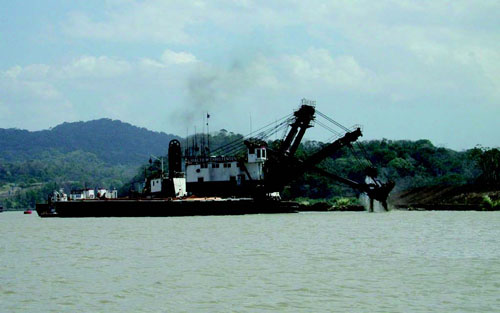
In 1973, while the Amalie Essberger was unloading molten phenol from a tank in the port of Gothenburg (Sweden), the tank burst and 400 tonnes of phenol were spilt onto the dock and into the water. Analysis detected the presence of large clusters of solidified pollutant on the bottom. These clusters were brought to the surface using a dredger•.
Containment, recovery and dispersion of floaters
The response equipment used for persistent floating products (vegetable oils and viscous chemicals) are inspired by those existing for oil pollution, but are preferably made of materials resistant to the chemicals in question.
Containment and recovery: when floating substances form a sufficiently thick and continuous slick, they can be contained by deploying floating booms then recovered using a skimmers• if the sea and weather conditions allow.
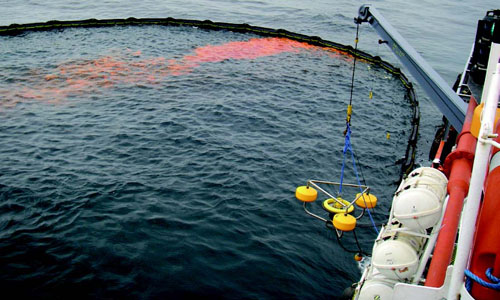
Dispersion: dispersants are products which speed
up the natural dispersion of pollutants in the water
column, by taking advantage of wave agitation. They
help to fragment slicks into a multitude of microdroplets
spread throughout the water column, which
speeds up their breakdown and bioassimilation in
the marine environment. Because of dispersants'
mode of action, their use is regulated. They should
not, for instance, be used in areas where dilution
levels are too low.
Trawling: if the pollutant is a paste, it can be recovered
offshore using trawl nets• towed by a single or
pair of vessels.
In 1997, the Allegra lost 900 tonnes of palm nut oil following a collision with a bulk carrier in the English Channel. The oil rapidly solidified to form a surface slick. Part of the oil was recovered offshore by trawling.
Sorbents: these products can be used in coastal or
port areas on small-scale spills. They are solid materials
used to retain floating substances by sorption,
in order to facilitate their subsequent recovery.
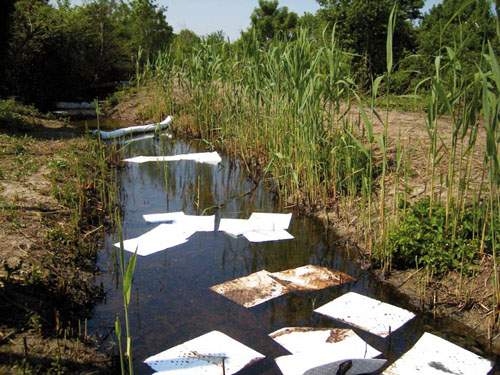
Operational Guide "Use of sorbents for spill response".
On land clean-up: when large quantities of vegetable
oil agglomerates are washed up on difficult access
sites (riprap•, pebble beaches), manual recovery is
necessary. If the areas affected are sandy beaches,
specialized equipment such as sand screeners• can
be used.
When the oil on the shoreline is liquid, the area
can be cleaned at low tide by flushing• with cold
water. The effluent• is recovered and settled, before
pumping off the oil.
Response operations are also conducted
in the case of chemical spills in inland
waters•. In 2008, a truck transporting 33.6
tonnes of concentrated phenol veered off
the road and spilt part of its cargo into
the Zhesang River (southern China). The pollutant
quickly reached a dam located 15 km
upstream of a water intake
supplying drinking water to 200,000 people.
The local authorities banned over
1,000 households in the city of Yangyu
from consuming the potentially
polluted water supply. Response teams
built makeshift dams to contain the pollution
and spread lime and activated carbon•
to capture as much pollutant as possible.